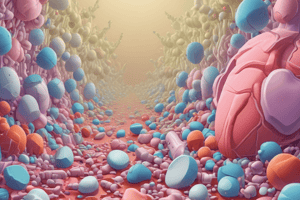Podcast
Questions and Answers
Which of the following subclass IA antiarrhythmic preparations is rarely used for supraventricular arrhythmias?
Which of the following subclass IA antiarrhythmic preparations is rarely used for supraventricular arrhythmias?
- Mexiletine
- Quinidine (correct)
- Procainamide
- Lidocaine
What is the primary indication for IV procainamide in subclass IA?
What is the primary indication for IV procainamide in subclass IA?
- Hemodynamically unstable ventricular tachycardia
- Hemodynamically stable ventricular tachycardia (correct)
- Supraventricular arrhythmias
- Refractory ventricular arrhythmias
What is the mechanism of action of beta-adrenoblocker preparations?
What is the mechanism of action of beta-adrenoblocker preparations?
- Blockade of myocardial β–adrenergic receptors (correct)
- Increase of AV conduction
- Enhancement of phase 4 depolarization
- Stimulation of the SA node
Which of the following subclass IB antiarrhythmic preparations is used for chronic treatment of ventricular arrhythmias?
Which of the following subclass IB antiarrhythmic preparations is used for chronic treatment of ventricular arrhythmias?
What is the primary indication for flecainide in subclass IC?
What is the primary indication for flecainide in subclass IC?
What is the effect of beta-adrenoblocker preparations on the SA node?
What is the effect of beta-adrenoblocker preparations on the SA node?
Which of the following subclass IA antiarrhythmic preparations is used for acute conversion of atrial fibrillation?
Which of the following subclass IA antiarrhythmic preparations is used for acute conversion of atrial fibrillation?
What is the effect of beta-adrenoblocker preparations on AV conduction?
What is the effect of beta-adrenoblocker preparations on AV conduction?
What is the primary indication for lidocaine in subclass IB?
What is the primary indication for lidocaine in subclass IB?
What is the effect of beta-adrenoblocker preparations on automaticity?
What is the effect of beta-adrenoblocker preparations on automaticity?
Flashcards are hidden until you start studying
Study Notes
Antianginal Effects of Calcium Channel Blockers
- Coronary artery dilatation and relief of coronary spasm (variant angina)
- Decrease myocardial O2 demand due to:
- Arteriolar dilatation, decreasing vascular resistance and afterload
- Decrease in heart rate (HR)
- Decrease in contractility
- Decrease in AV conductivity
Preparations Used to Abolish Angina Pectoris Attacks
- Organic nitrates:
- Nitroglycerin
- Isosorbide dinitrate
- Isosorbide mononitrate
- Trinitrolong
- Nitrong
- Ca channel blocking drugs:
- Nifedipine
- Diltiazem
- Verapamil
- Mibefradil
- K channel activators:
- Minoxidil
- Pinacidil
- Nicorandil
- Diazoxide
- Various drugs:
- Amiodarone
Groups and Preparations Used in Acute Myocardial Infarction
- Opioid drugs:
- Fentanyl
- Morphine
- Trimeperidine
- Anxiolytics:
- Tranquilizers (diazepam)
- Neuroleptics
- Neurolepanalgesia (fentanyl, droperidol or talamonal)
- Prevention of arrhythmias:
- Antiarrhythmics (lidocaine)
- Improvement of circulation:
- Hexamethonium
- Furasemide
- Triperium iodide
- Dopamine
- Norepinephrine
- Phenylephrine
- Prevention of thromboses:
- Anticoagulators (heparin)
- Antiaggregants (fibrinolysine, aspirin)
- Acido-base equilibrium:
- Na bicarbonate
- Dextran 40, 70
- Cardiac failure:
- Cardiotonics (dopamine, glycosides)
- Decrease necrotic area:
- Nitroglycerine
- Amelioration of myocardial metabolism:
- Cardioprotectors (omopatrylate, trimethasidine)
- Antioxidants (coenzyme Q10)
Adenosine
- Based on the influence on the efferent cardiac innervations
- Remedies that stimulate the adrenergic influence:
- β adrenomimetics (izoprenaline)
- Sympathomimetics (ephedrine)
- Remedies with cholinergic influence:
- Anticholinesterases (Edrophonium)
- α adrenomimetics (phenylephrine)
- Remedies that decrease cholinergic action:
- Atropine
Antiarrhythmic Preparations
- Class II – Beta-adrenoblockers:
- Propranolol
- Metoprolol
- Nadolol
- Atenolol
- Acebutolol
- Pindolol
- Sotalol
- Timolol
- Esmolol
- Class III – K+ channel blockers:
- Amiodarone
- Ibutilide
- Bretylium
- Dofetilide
- Sotalol
- Class IV - Ca2+ channel blockers:
- Verapamil
- Diltiazem
- Galapamil
- Nifidifin
- Alinidin
Indications for Antiarrhythmic Preparations
- Subclass IA:
- Supraventricular (atrial) and ventricular arrhythmias
- Quinidine is rarely used for supraventricular arrhythmias
- Oral quinidine/procainamide are used with class III drugs in refractory ventricular tachycardia patients with implantable defibrillator
- IV procainamide used for hemodynamically stable ventricular tachycardia
- IV procainamide is used for acute conversion of atrial fibrillation including Wolff-Parkinson-White Syndrome (WPWS)
- Subclass IB:
- Lidocaine is the drug of choice in emergency treatment of ventricular arrhythmias
- Mexiletine is used for chronic treatment of ventricular arrhythmias associated with previous myocardial infarction
- They are used in the treatment of ventricular arrhythmias arising during myocardial ischemia or due to digoxin toxicity
- They have little effect on atrial or AV junction arrhythmias (because they don’t act on conduction velocity)
- Subclass IC:
- Refractory ventricular arrhythmias
- Flecainide is a particularly potent suppressant of premature ventricular contractions (beats)
- Supraventricular arrhythmias
- Flecainide: Prophylaxis in paroxysmal AF
Mechanism of Action and Antiarrhythmic Effect of Beta-Adrenoblocker Preparations
- Blockade of myocardial β–adrenergic receptors
- Direct membrane-stabilizing effects related to Na+ channel blockade
- Slows SA node and ectopic pacemaking
- Increase refractory period
- Negative inotropic and chronotropic action
- Prolong (decrease) AV conduction (delay)
- Diminish phase 4 depolarization, suppressing automaticity (of ectopic focus)
Studying That Suits You
Use AI to generate personalized quizzes and flashcards to suit your learning preferences.




